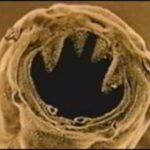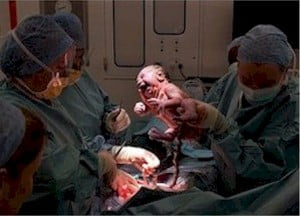Hookworms
This parasite is most commonly known to occur in puppies but sometimes will occur in older dogs. This type of intestinal worm will hook itself onto the walls of the intestines and there it will suck on tiny blood vessels. The hookworm parasite lives in the environment such as moist grass and damp soils. Severe hookworm infestations cases can lead to anemia and possible death. Possible symptoms of hookworms could be diarrhea and pale gums. This intestinal parasite can only be seen microscopically and is about half of an inch in length and has a tiny hook on one end of its body and there are tiny teeth which the parasite hangs onto the intestinal walls with.
Whipworms
This type of parasite can only be seen from underneath a microscope. They are oval shaped and the inside of the cell looks like tiny brown air bubbles and there is a brown nucleus around it. They live in the soil and animals can contact this from ingestion of an egg by licking their paws or by playing with a toy that has been infested. Symptoms can be weight loss or bloody diarrhea.
Roundworms
Unlike hookworms and whipworms that can only be seen under a microscope these worms can be seen in the animal’s feces. They are white and look exactly like long thin strings of spaghetti. This type of parasite most often will target the young puppies up to six months of age. Symptoms can be diarrhea and weight loss.
Tapeworms
This one can be seen by the eye and they resemble grains of white rice which is only one section of the tapeworm. They can also be longer in shape and look like a long flat white piece of ribbon. Animals contact these by the ingestion of fleas.
There are other types of intestinal diseases that can occur in dogs and cats.
Coccidia
This intestinal parasite does not have any resemblance to a worm and can only be seen under a microscope. They have an oval shape to them and the inside of these look like air bubbles joined together to form one cell and this is all surrounded by a clear nucleus. This type of parasite typically targets younger animals especially kittens and puppies from as young as two weeks of age and up. It can cause bloody diarrhea with some mucous being noticed as well. Severe infestations of coccidia can be fatal.
Giardia
This parasite has no resemblance of a worm and can only be seen microscopically and they attach themselves to the small intestines. Puppies and kittens are the most susceptible targets to this rare disease. Some symptoms that may be noticed are diarrhea, lethargy and weight loss.
Humans can get hookworms through infective larvae that penetrate the skin; i.e. walking barefoot through the backyard or in a park and then stepping in feces with the larvae in it. Although this does occur in the United States it is primarily a bigger problem in third world countries.
The way for humans to get whipworms and or roundworms would require the ingestion of a piece of the poop. To give you an example of this, let’s say that you have a sandbox in your backyard and there is some dog or cat poop in that sandbox that looks just like a tootsie roll. A person or child would have to pick this piece of poop up and put it into their mouths.
Just remember to remove and dispose of your pet’s feces. This is a great way for the prevention against any and or all of the intestinal parasites. This will also help to prevent any further contamination to the environment.
Always wash your hands with warm water and use an anti bacterial soap after playing with any pet or after you pick up any feces. If you go barefooted outdoors just remember to wash those feet off with an anti bacterial soap and warm water.
DISCLAIMER
I am not a licensed vet but I did learn a lot of valuable information during my years working for one.





